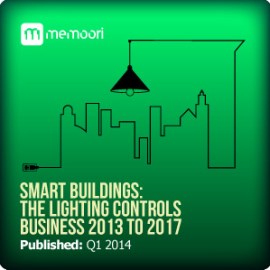
by Brianna Crandall — February 5, 2014—The world value of lighting control products in 2013 was approximately $1.67 billion at factory gate prices, and the global market for lighting controls from 2013 to 2020 is forecasted to grow at a compound annual growth rate (CAGR) of 12%, according to a new report from independent market research and consultancy provider Memoori Business Intelligence.
According to the Smart Buildings: The Lighting Controls Business 2013 to 2017 report, a major factor that will determine growth of lighting controls over the next seven years will be the level of penetration achieved in opening up the retrofit market, which has seen little growth over the last 15 years and still only accounts for 10% of the total lighting controls business. Wireless technology can open up this market, bringing down installation costs and significantly improving the return on investment (ROI), adds the report.
Memoori’s report also shows that it is the impact of light-emitting diode (LED) technology that is providing vast opportunities to improve lighting products and their efficiency. This has coincided with the mandated demand to reduce CO2 emissions in buildings, creating a unique and challenging opportunity. Although the manufacture and design of lighting controls is for the most part a separate business, the introduction of LED lighting reportedly opens up new possibilities for enhanced control and also extends it further across the “Internet of Things.”
The report also shows that some 32% of the value of the lighting controls market goes into office buildings, which is by far the largest market, but nevertheless has come down from some 50% in 1996. The next largest market by building type is the retail sector, with a 12% market share. This sector reportedly has the potential to increase its share over the next five years, particularly in developed markets across the world.
At 156 pages, with 34 charts and tables, the Smart Buildings: The Lighting Controls Business 2013 to 2017 report describes what is shaping the future of the lighting industry; who the lighting giants of the future will be; and how technology, and specifically LED technology, is influencing the future of lighting control, and the strategic effect it will have on business and investments.





